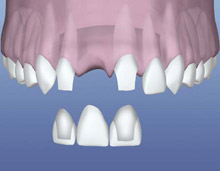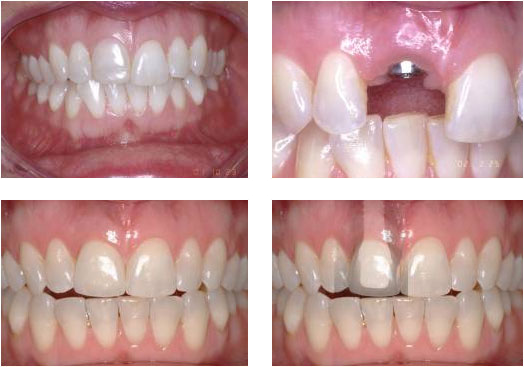In some situations the tooth is not salvageable. This can occur due the presence of severe caries (cavities) that leave insufficient sound tooth structure to warrant reconstruction, poor periodontal support (irreversible gum disease) or teeth with root fractures. Should this occur, you generally have 3 alternatives:
1
Extraction and No Replacement
This is the least desirable situation. Although the consequences of this decision may not be apparent initially, leaving spaces in the mouth can lead to long term severe problems with the adjacent teeth. Over time, the adjacent teeth can begin to tilt. This can cause spaces in between teeth (open contacts) that tend to collect food, contribute to further difficulties with eating and higher incidence of cavities.
Extraction of a tooth can also lead to “supra-eruption” of the opposing teeth – creating problems with an uneven occlusion (bite). Tilting of the teeth adjacent to the space can also cause problems, should we choose to try to reconstruct the area in the future.
2
Extraction and Fixed Bridge Replacement
With this treatment, a permanently cemented bridge is placed that replaces the missing extracted tooth. Although at first glance this appears to be a more economical solution than Endodontic treatment/Crown, we must look more closely at what is involved. Should we wish to place an artificial tooth in the space created by the extraction, we must use the adjacent teeth as “abutments” (The teeth that hold up the bridge.) To replace one missing tooth, we generally must support the bridge one tooth forward and one tooth behind the space created by the extraction. This is called a “3 Unit Bridge”.
Figure 1
Visual Render of a Fixed Bridge Replacement.

The problem with this is that these two adjacent teeth must be cut down (prepared) for crowns. In some cases, this can mean cutting into perfectly virgin teeth. In other cases, these teeth may have been deeply filled as well and the stress of preparation can sometimes cause these teeth to become endodontically involved. So in many cases one of the abutments must also be endodontically treated as well, before or after the bridge is cemented.
We also must remember that a bridge must have “2 sides”. We cannot use this treatment with “back teeth” that have nothing behind them. Bridge replacement involves placing two crowns and that is generally more expensive than just restoring the tooth with a single Endodontic treatment and single Crown.
Most insurance plans will partly pay for the cost of a bridge, though some will not. You should check with your Dentist and your individual plan before making this decision.
3
Extraction and Implant Replacement
Implant replacement is the more desirable way of replacing a missing tooth. In this treatment a special metal cylinder is placed in the socket where the previous tooth was extracted. The implant is made of special material and design that allows it to become “osseointegrated” – which means that it literally becomes attached to the jawbone. Most often this can take between 6 and 12 months and during that time an artificial tooth or temporary denture is worn.
After the implant is ready to be loaded, a bolt-like structure is screwed or cemented into the implant and this is used to retain a crown. Implants are an excellent solution where the patient has good bone and good hygiene. In other situations (such as placement near the sinuses, in smokers, patients with poor periodontal condition and people who heavily grind their teeth) implant treatment may not be advised or may have a poorer long term prognosis.
Figure 2
Single Tooth Implant Replacement


Figure 3
Implant replacement of front tooth
(Illustrations Courtesy Dr. Ken Serota).
This patient had her upper right central incisor knocked out as a child. Over time, the root resorbed, the crown discoloured and she needed to have the tooth removed and replaced. Rather than have a fixed bridge, she elected to have it replaced with an implant. The implant is inserted and must be left undisturbed until it binds to the bone (osseointegrates) which may take 4-6 months or more. Once the implant is confirmed to be secure, a porcelain crown was fitted and cemented in place. The aesthetic appearance (even at this level of magnification) is excellent. The implant secured crown looks and functions just like a natural root.
Implant restored teeth also are not covered by most insurance plans and can cost from $3,500-$5,000 each, (depending on who performs treatment.). Dr. Kaufmann does not perform implant treatment . Should you wish to pursue this course of treatment, Dr. Kaufmann will be happy to consult with your Dentist and advise you on how to best proceed. For more detailed information implants, click here.
